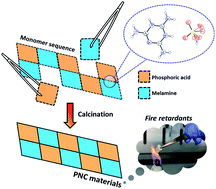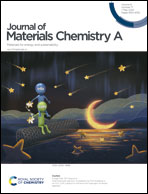Synthesis of metal-free lightweight materials with sequence-encoded properties†
Abstract
A high-temperature solid-state synthesis is a widespread tool for the construction of metal-free materials, owing to its simplicity and scalability. However, no method is currently available for the synthesis of metal-free materials, which enables control over the atomic ratio and spatial organization of several heteroatoms. Here we report a general and large-scale synthesis of phosphorus–nitrogen–carbon (PNC) materials with highly controllable elemental composition and structural, electronic, and thermal stability properties. To do so, we designed four different crystals consisting of melamine and phosphoric acid with different monomers sequences as the starting precursors. The monomer sequence of the crystals is preserved upon calcination (up to 800 °C) to an unprecedented degree, which leads to precise control over the composition of the final PNC materials. The latter exhibit a remarkable stability up to 970 °C in air, positioning them as sustainable, lightweight supports for catalysts in high-temperature reactions as well as halogen-free fire-retardant materials.



 Please wait while we load your content...
Please wait while we load your content...